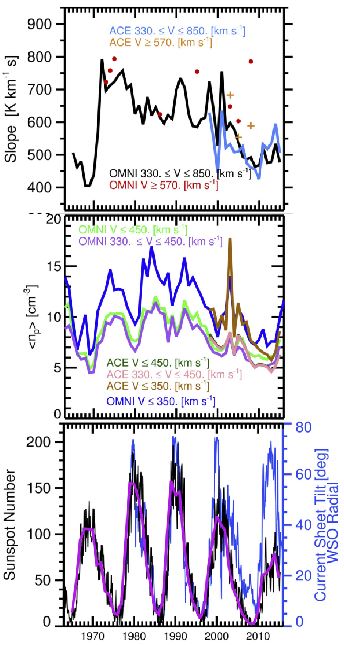Long-Term Trends In The Solar Wind Proton Measurements
PDF version
Most of the time the solar wind proton speed and temperature are positively correlated and well described by a linear relationship. The Sun occasionally and sporadically releases large massive amounts of material from the Sun referred to as Coronal Mass Ejections (CMEs), which look like large bubbles emanating from the Sun. In these CMEs the correlation between the solar wind speed and temperature breaks down. The solar wind proton density and speed are generally anticorrelated, but the density is highly variable quantity and the relationship between the proton density and speed is not as distinct as that between the temperature and speed.
| Figure 1: The steepness in the slope of the solar wind proton temperature-speed relationship (top panel) slowly decreased over the course of 3 solar cycles. The bottom panel shows the solar cycle variation in the Sun's sunspot number (monthly average in black, and running average in pink) and the heliospheric current sheet tilt angle. The middle panel shows that the slow solar wind has solar cycle variation in proton density that is out of phase (shifted by 4 years) [Elliott et al., 2016]. |

|
We examined the long-term time evolution (1965-2015) of the relationships between solar wind proton temperature, speed, and density using OMNI and Advanced Composition Explorer (ACE) solar wind observations taken near Earth. We found a long-term decrease in the proton temperature-speed slope that lasted from 1972 to 2010, but recently has been trending upward since 2010 [see Elliott et al., 2016]. This long-term trend is important since empirical formulas based on fits to the proton speed and temperature data are commonly used to identify when a spacecraft taking in situ solar wind measurements encounters a CME, but these formulas do not include any time dependence.
We examined the average proton density for different speed ranges, and found that for the slow solar wind the density is highly correlated with the sunspot number, with a lag of approximately 4 years. The fast wind density variation was less, but in phase with the cycle. This phase difference likely contributes to the relationship between the density and speed variations [see Elliott et al., 2016]. We found that the steepness in the density-speed relationship is correlated with the solar cycle. Changes in the solar wind density over a solar cycle will create corresponding changes in the near-Earth space environment and the overall extent of the heliosphere.
This item was contributed by Heather A. Elliott of Southwest Research Institute. Address questions and comments to
ACE News Archives
Subscribe to ACE News
ACE Homepage
Last modified 20 Mar 2017.